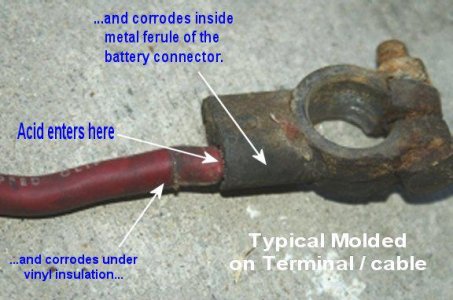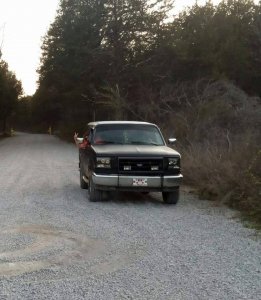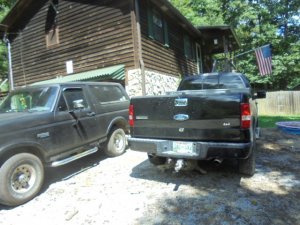Yo Steve,
Voltage; "...a normal battery that is fully charged produces 12.6 volts, not just 12.0 V. (Remember, when measuring battery voltage, everything in the car should be off, or the battery should be disconnected. Voltage measurements are always "no load" measurements unless the battery is being tested for it's performance under load)..." by Gordon
Check both battery posts, cables, connectors & major GROUND cables for looseness and corrosion. If you see corrosion on a cables' wires strands between connectors or lugs and leading into the insulation, peel back the insulation to see how far back it reaches.

by El Kabong @
"Cheesy clamp on end. Do not use for a long term repair. Only to get you home when nothing else is available. If you have one of these, suspect it before anything else" El Kabong @
Common Replies to FAQs
Check starter relay for looseness or rust to the inner fender. It's ground is through its body to the inner fender.
Check that starter is mounted securely and connectors are clean and tight
CHECK GROUND CABLES to frame, block etc.
Slow Cranking or a Grinding Noise; "... Problems with the negative battery cable is a major cause of starting problems in Ford, Lincoln, and Mercury vehicles. Bad battery cables can cause slow cranking or a grinding noise when trying to start an engine. ..,the wire connection inside the battery terminal connector corrodes easily. This will cause a voltage drop in the cable and result in low voltage being supplied to the starter. You can check for voltage drop in the cable using a digital voltmeter. Connect the negative probe of the voltmeter to the negative battery post (not the battery terminal connector). Then connect the positive probe to the starter case and crank the engine. The voltage reading should be less than .5 volts. A higher reading means there is resistance in the cable or the battery terminal connector. Clean the cable end and the battery terminal connector and test again. If the voltage reading is still higher than .5 volts, replace the cable and the battery terminal connector..."
Source: by genco1.com
Voltage; "...a normal battery that is fully charged produces 12.6 volts, not just 12.0 V. (Remember, when measuring battery voltage, everything in the car should be off, or the battery should be disconnected. Voltage measurements are always "no load" measurements unless the battery is being tested for it's performance under load)..."
Source: by Gordon
"Long crank times may be traced to a sticking Idle Air Control (IAC) valve (TSB 97-9-5, April '97); "...After a 1-4 hour engine soak time, long crank times and/or long crank to start followed by a stall may occur on some vehicles. No further stalling or rough idle will occur after the engine is running. The long crank and/or stall may be due to the Idle Air Control (IAC) Valve sticking. Replace the IAC Valve with a revised IAC Valve if no Diagnostic Trouble Codes (DTCs) are present."
Ford Motorcraft units are best."
Idle Air Control (IAC) Sludge; Poor Idle TSB 91-25-07 for 85-92 Bronco & F Series & many others; "...That is an adjustable idle plate....aka....idle air metering block...aka idle-fixer. You can get it from your Ford dealer. Last one I bought for a customer's truck was about $85 and it came with new mounting screws. made my own (fixed-orfice) plate by cutting a piece of 1/8" flat bar to the shape of my IAC Valve gasket and drilling the passage holes 3/32". I started with 1/16" holes but that weren't quite large enough for my particular engine. Point there is that different engines may require their own orfice size....hence the two adjustments on the Ford (factory) version. These things have been in use for 15 years that I know of, maybe more.....which tells me that Ford has known all along that they had a design glitch in their EFI idle air valve system..."
Source: by DGW1949 at FSB
●
URL="http://broncozone.com/topic/14269-code-reader/?pid=74587&mode=threaded"]Try a Self Test for Diagnostic Trouble Codes (DTC)s[/URL] by my pal, BroncoJoe19 ☆







